Honored repeatedly by his peers, Dr. Shapiro has been called one of “the nation’s top refractive surgeons” by Primary Care Optometry News, and a world leader in refractive surgery by EyeWorld, two leading eye care journals. NBC News in Los Angeles has called Dr. Shapiro “one of the country’s top laser surgeons.” Dr. Shapiro was listed in EyeWorld’s international survey as one of 30 world leaders in LASIK surgery and awarded a “Star Surgeon” award by VISX, the manufacturer of the leading excimer laser system in the United States, an honor awarded to the top five percent of LASIK surgeons in the country. He has been selected as an FDA clinical investigator for evaluating the safe use of LASIK and has helped teach refractive surgery to over 1,000 eye surgeons from around the world. Dr. Shapiro was one of the first surgeons in the world to publish an article in a medical journal about customized wavefront LASIK and has been an international leader in fostering the clinical development of this breakthrough technology. Ultimately, your results are dependent on your surgeon, not just on the technology used. Surgical skill and advanced technology are the keys to safe, successful outcomes.
The Shapiro Laser Eye Center is committed to using the most advanced, most accurate, and most safe technology possible. Dr. Shapiro has authored scientific papers on new technologies in refractive surgery and has served as an FDA clinical investigator to evaluate the safety of various formats of LASIK surgery.
NASA DERIVED WAVEFRONT TECHNOLOGY 
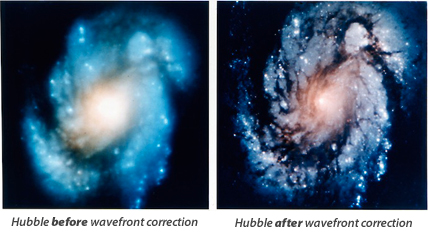 The wavefront technology Dr. Shapiro uses for customized wavefront laser eye surgery has its origins in NASA’s astrophysics program. To look into deep space, land based telescopes need to look through atmospheric distortion which, like the human eye, is a complicated and non-uniform optical system. Recent advances by NASA led to development of a technology known as wavefront analysis, which allows us to measure complex, irregular optical systems ranging from astronomy to the human eye with vastly more precision than previously possible. In fact, NASA used wavefront technology to improve the optics of the Hubble Space Telescope to look into deepest Space. Through wavefront analysis, we now know that our concept of merely using standardized lenses addressing nearsightedness, farsightedness, and astigmatism to correct the eye was too simplistic.
The wavefront technology Dr. Shapiro uses for customized wavefront laser eye surgery has its origins in NASA’s astrophysics program. To look into deep space, land based telescopes need to look through atmospheric distortion which, like the human eye, is a complicated and non-uniform optical system. Recent advances by NASA led to development of a technology known as wavefront analysis, which allows us to measure complex, irregular optical systems ranging from astronomy to the human eye with vastly more precision than previously possible. In fact, NASA used wavefront technology to improve the optics of the Hubble Space Telescope to look into deepest Space. Through wavefront analysis, we now know that our concept of merely using standardized lenses addressing nearsightedness, farsightedness, and astigmatism to correct the eye was too simplistic.
VISX CUSTOMVUE WAVESCAN WAVEFRONT ABERROMETER
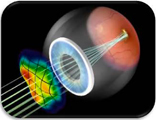 Incorporating NASA technology, infra-red lasers map the optics of your eye by traveling through your eye and being reflected back to ultra high resolution sensors capable of measurements 25 times more accurate than glasses or contacts. From these laser measurements, the Wavescan Aberrometer creates a highly precise three dimensional wavefront map of the micro-distortions in your eye, intricate optical distortions called your “optical fingerprint” which are as complex — and as unique to you — as your own fingerprint is. Your personal optical fingerprint map, unique to your eye, is downloaded into the VISX S4 IR Excimer Laser and treated on your eye with billionth of an inch tolerances. In this way, laser vision correction is customized specifically to your eye, potentially enabling vision better than glasses or contacts.
Incorporating NASA technology, infra-red lasers map the optics of your eye by traveling through your eye and being reflected back to ultra high resolution sensors capable of measurements 25 times more accurate than glasses or contacts. From these laser measurements, the Wavescan Aberrometer creates a highly precise three dimensional wavefront map of the micro-distortions in your eye, intricate optical distortions called your “optical fingerprint” which are as complex — and as unique to you — as your own fingerprint is. Your personal optical fingerprint map, unique to your eye, is downloaded into the VISX S4 IR Excimer Laser and treated on your eye with billionth of an inch tolerances. In this way, laser vision correction is customized specifically to your eye, potentially enabling vision better than glasses or contacts.
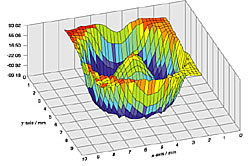 The VISX Wavescan is used by Dr. Shapiro to create the personal three dimensional wavefront map, or “optical fingerprint”, of the your eye. An invisible infra-red laser is shined into your eye and over 200 sophisticated sensors map out distortions in the returning reflection of this laser from the back surface of your eye to create your optical fingerprint, which is as unique to you, and as complex, as the fingerprint on your fingertip. To ensure accuracy, four distinct wavefront maps are created within milliseconds and they are cross-checked to be sure they correlate with each other. This complex three dimensional map of your optical fingerprint is then downloaded directly into the laser, which in turn treats it with billionth of an inch accuracy. This allows a level of precision of treatment which is beyond that of glass or contact lenses.
The VISX Wavescan is used by Dr. Shapiro to create the personal three dimensional wavefront map, or “optical fingerprint”, of the your eye. An invisible infra-red laser is shined into your eye and over 200 sophisticated sensors map out distortions in the returning reflection of this laser from the back surface of your eye to create your optical fingerprint, which is as unique to you, and as complex, as the fingerprint on your fingertip. To ensure accuracy, four distinct wavefront maps are created within milliseconds and they are cross-checked to be sure they correlate with each other. This complex three dimensional map of your optical fingerprint is then downloaded directly into the laser, which in turn treats it with billionth of an inch accuracy. This allows a level of precision of treatment which is beyond that of glass or contact lenses.
VISX S4 IR EXCIMER LASER
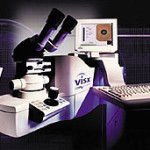 Dr. Shapiro uses the newest generation VISX S4 IR excimer laser system, the most advanced excimer laser system made. Although it can also be used for conventional LASIK, the S4 IR VISX laser specifically was engineered to be a wavefront driven platform, technologically optimized for incorporating the Wavescan-derived ultra high resolution optical fingerprint and applying it to the surface of the cornea with billionth of an inch precision on a moving target.
Dr. Shapiro uses the newest generation VISX S4 IR excimer laser system, the most advanced excimer laser system made. Although it can also be used for conventional LASIK, the S4 IR VISX laser specifically was engineered to be a wavefront driven platform, technologically optimized for incorporating the Wavescan-derived ultra high resolution optical fingerprint and applying it to the surface of the cornea with billionth of an inch precision on a moving target.
In order to achieve the level of precision needed to optimally create wavefront based sculpting, the latest generation VISX S4 IR has several technological breakthroughs including three dimensional eye tracking, iris based laser targeting and alignment systems, and smart beam technology incorporating infinitely variable laser spot sizes and application rates during surgery.
THREE DIMENSIONAL EYE TRACKING
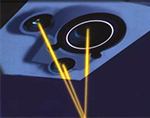 This advanced technology, based on missile tracking technology used in military applications, utilizes an infra-red computer guided three dimensional eye tracking system which allows billionth of an inch accuracy on a very rapidly moving target. The three dimensional eye tracker supersedes older two dimensional systems. During the laser procedure, this revolutionary eye tracker locks onto the eye, following its most minute movements in three dimensional space.
This advanced technology, based on missile tracking technology used in military applications, utilizes an infra-red computer guided three dimensional eye tracking system which allows billionth of an inch accuracy on a very rapidly moving target. The three dimensional eye tracker supersedes older two dimensional systems. During the laser procedure, this revolutionary eye tracker locks onto the eye, following its most minute movements in three dimensional space.
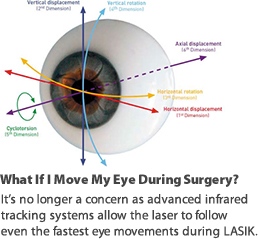 In turn, the eye tracking technology drives a laser guidance system which allows perfect placement of the laser beam onto the eye throughout eye movement, even if your are unable to hold still or look consistently ahead. Eye movement during surgery is now no longer a concern because the advanced computerized tracking technology allows the laser beam to actually follow even the fastest eye movements to allow perfect placement of each laser pulse regardless of eye movement, improving both the accuracy and the safety of laser vision correction.
In turn, the eye tracking technology drives a laser guidance system which allows perfect placement of the laser beam onto the eye throughout eye movement, even if your are unable to hold still or look consistently ahead. Eye movement during surgery is now no longer a concern because the advanced computerized tracking technology allows the laser beam to actually follow even the fastest eye movements to allow perfect placement of each laser pulse regardless of eye movement, improving both the accuracy and the safety of laser vision correction.
IRIS BASED LASER TARGETING AND ALIGNMENT SYSTEMS
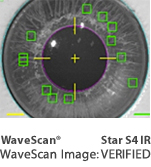 The laser’s computer not only allows three dimensional eye tracking, but is able to perfectly “lock-on” to the perfect position on the eye when tracking is initiated, ensuring the optical fingerprint is exactly lined up in the correct position on the cornea. To achieve such perfect alignment of the laser onto the eye, iris registration systems based on security systems technology are employed. Simultaneous to mapping the three dimensional optical fingerprint with the Wavescan, the laser’s computer maps the entire iris (colored part of your eye), identifying hundreds of landmarks. At the time of surgery, the computer seeks out these same iris landmarks to allow perfect placement of the wavefront laser onto the eye, both in terms of rotational alignment and centration. This advanced targeting and alignment system is unique to the VISX S4 IR excimer laser.
The laser’s computer not only allows three dimensional eye tracking, but is able to perfectly “lock-on” to the perfect position on the eye when tracking is initiated, ensuring the optical fingerprint is exactly lined up in the correct position on the cornea. To achieve such perfect alignment of the laser onto the eye, iris registration systems based on security systems technology are employed. Simultaneous to mapping the three dimensional optical fingerprint with the Wavescan, the laser’s computer maps the entire iris (colored part of your eye), identifying hundreds of landmarks. At the time of surgery, the computer seeks out these same iris landmarks to allow perfect placement of the wavefront laser onto the eye, both in terms of rotational alignment and centration. This advanced targeting and alignment system is unique to the VISX S4 IR excimer laser.
SMART BEAM TECHNOLOGY 1: VARIABLE SPOT SCANNING (VSS)
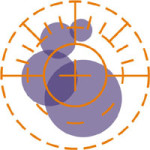 Traditionally, excimer lasers have used a single laser spot size to sculpt in a desired shape. The VISX S4 IR, by contrast, utilizes a scanning array laser beam with infinitely variable spot sizes ranging from 0.65 mm to 6.5 mm, which has been shown to be best able to replicate the intricate complexity of shape and curvature when treating the optical fingerprint. To understand the importance of this technology, think of how a painter painting a room benefits from multiple paint brushes, from a small detail brush to a large roller brush, and everything in between — rather than just using a single brush. The variable spot size and shaped technology technology, also called “SmartBeam” technology, also allows a wide total laser ablation diameter of up to 9.0 mm for patients with large pupils. When a wavefront based LASIK procedure is performed with the VISX S4IR using variable spot scanning, advanced microprocessors perform over one billion calculations to determine the mathematically optimal combination of laser pulse sizes and shapes to most perfectly created the desired tissue sculpting. Variable spot scanning is unique to the VISX S4 IR excimer laser.
Traditionally, excimer lasers have used a single laser spot size to sculpt in a desired shape. The VISX S4 IR, by contrast, utilizes a scanning array laser beam with infinitely variable spot sizes ranging from 0.65 mm to 6.5 mm, which has been shown to be best able to replicate the intricate complexity of shape and curvature when treating the optical fingerprint. To understand the importance of this technology, think of how a painter painting a room benefits from multiple paint brushes, from a small detail brush to a large roller brush, and everything in between — rather than just using a single brush. The variable spot size and shaped technology technology, also called “SmartBeam” technology, also allows a wide total laser ablation diameter of up to 9.0 mm for patients with large pupils. When a wavefront based LASIK procedure is performed with the VISX S4IR using variable spot scanning, advanced microprocessors perform over one billion calculations to determine the mathematically optimal combination of laser pulse sizes and shapes to most perfectly created the desired tissue sculpting. Variable spot scanning is unique to the VISX S4 IR excimer laser.
SMART BEAM TECHNOLOGY 2: VARIABLE REPETITION RATE (VRR)
Because Variable Spot Scanning Smart Beam technology allows the application of a infinitely variable array of laser spot diameters to custom-sculpt an individual’s optical fingerprint, it is important to vary the rate at which the laser is applied to the tissue in order to keep the total energy applied to the laser in a tight envelope. Smaller spots can be applied much more rapidly since each spot delivers proportionally less energy to the cornea than a larger spot. By strategically slowing the laser for larger spot sizes, a uniform amount of energy per time can be applied, which leads to more optimal results. Because VSS technology allows a infinitely adjustable spot size between 0.65 mm and 6.5 mm, the rate of laser application is similarly adjusted with infinite variation. Before a treatment is applied, the computer in the VISX S4 IR will “play” your entire treatment and then appropriately program-in variations in the speed of laser application, unique to your optical fingerprint treatment requirements, to keep the application of energy uniform over the course of your treatment. Even with variable repetition rate technology, total laser treatment times are typically under 30 seconds. Variable Repetition Rate technology is unique to the VISX S4 IR excimer laser.
OTHER LASIK TECHNOLOGY
Before surgery, each patient’s eye is measured in various ways. Each patient undergoes wavefront analysis with the VISX Wavescan to produce the patient’s unique Waveprint, or customized depiction of both the internal and external optics of the eye. Corneal topography, or corneal contour mapping, is performed and computerized statistical analysis is performed on these topographical maps to try to detect any shape anomalies which could increase surgical risk and therefore be contraindications to surgery. The refraction is measured three times prior to surgery to ensure accuracy. Pupil sizes are measured before surgery and corneal thickness is measured using a high performance, high frequency ultrasonic pachymeter. Dr. Shapiro personally examines every patient before surgery.
LASER SUITE ENVIRONMENT
Also of great importance to achieving the most accurate and reproducible results is the environment the eye is in during surgery. Dr. Shapiro, in conjunction with laser engineers, has developed a unique laser suite in which the procedure is performed. In this laser facility, sophisticated microfiltration systems, UV sterilization of incoming airflow, and environmental controls are used to optimize air purity, temperature, humidity and flow rates — all critical to achieving the best possible results. The Shapiro Laser Eye Center has one of the few such environmentally regulated laser suites in California.
SURGICAL TECHNICIANS
Along with Dr. Shapiro, the surgical technicians at the Shapiro Laser Eye Center are an important part of the equation of your success. They calibrate the sophisticated instrumentation used by Dr. Shapiro and assist him in surgery. Dr. Shapiro’s highly trained technicians and surgical assistants have been with him for 20 years and over 25,000 cases. With Dr. Shapiro, they form a team dedicated to your best possible outcome and highest possible levels of safety.
